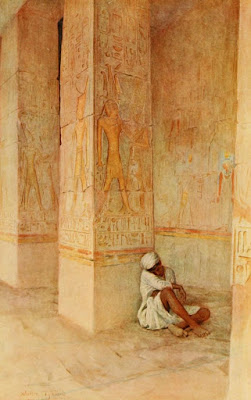We now return to the north, or Birth Colonnade, the reliefs on the rear
wall of which represent the state fiction by which Hatshepsut was regarded as
the actual child of Amûn by the Queen Ahmôse, the wife of Tuthmosis I .
The series has suffered considerably both from family jealousies and
religious prejudices ; and Ramses II has not improved things by the crude
colouring with which he has bedaubed the delicate reliefs .
The scenes begin at the north end of the colonnade, beside the ascending
ramp, with a council of the gods in the presence of Amûn .
Then we see Thoth leading Amûn ( both almost entirely erased ) into the
chamber of Queen Ahmôse .
And next Amûn seated face to face with the queen, and impregnating her
with the ankh, the divine breath of life, which is held to
her nose . The seats on which the god and the queen are seated are borne up in
the heavens, as in the parallel scene of Amenhotep III at Luxor Temple, by two
goddesses who sit upon a lion-headed couch .
Then we see the ram-headed creator-god Khnûm, getting instructions from
Amûn, and ( partly erased ) shaping Hatshepsut and her Ka upon his potter's wheel .
While the frog-headed goddess Heqt ( Heqet or Heket or Heqat, was a
goddess of childbirth and fertility ) puts the breath of life into the nostrils
of the newly created babe .
Thoth appears to Queen Ahmôse, and warns her of her approaching
accouchement .
And Khnûm and Heqt lead the queen to the birth-chamber .
The scene of the birth is very remarkable, and is handled with great
reticence and delicacy . The queen sits on a chair, with her woman attending on
her . The chair is placed on a lion-headed couch, which is upheld by various
gods, and stands in turn upon another lion-headed couch, also supported beneath
by gods .
Among the deities in the scene are Bes and Thouêris ( Taurt ), the
hideous patrons of child-birth .
Hathor next presents Hatshepsut to Amûn .
And twelve goddesses suckle the twelve Kas ( plural of Ka ) of the divine child, Hatshepsut .
Next Thoth and Amûn hold the child and her Ka ( erased in both cases ) .
Finally Hatshepsut and her Ka ( both erased ) are seen in the hands of
various goddesses .
And Safkhet ( Seshat ), the recording goddess of history, writes the
record of her birth .
The remaining scenes of the north colonnade refer to the queen's
presentation to the gods of Egypt, her presentation by her earthly father,
Tuthmosis I, to the magnates of the land, and her coronation .
Part ( 6 ) .. Coming SoOoOon .....
Uploading .....



















Thank you for this resource!
ReplyDeletewhere did you find these pictures? Do you have a reference?
ReplyDeleteThis is a fascinating account of Hatshepsut's birth story.
ReplyDelete